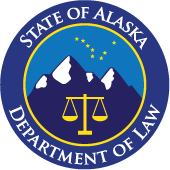Press Release
Governor Seeks Increased Penalties for Certain Illegal Drugs
Proposed legislation supplements current prohibitions on methamphetamines; Targets marijuana possession
January 21, 2005
(Juneau) - Governor Frank H. Murkowski delivered to the legislature today two crime bills that would increase the consequences for drug-related crimes, including the manufacture of methamphetamines ("meth"), and the penalties for possession of marijuana.
The illegal drugs/meth bill (House Bill 99, Senate Bill 70) proposes three changes to the current law. First, it clarifies that a manufacturer or deliverer of a controlled substance can be charged with manslaughter if the substance causes the death of a person ingesting the drug. The bill also makes possession of meth in organic solution a class A felony if the person possessing the solution intends to extract powdered meth from it. Finally, the legislation would make it a class C felony to manufacture meth in a building where children reside.
"From creation to consumption methamphetamines are the time bomb of the illegal drug trade," said Murkowski. "Today this illicit cottage industry is the equivalent of building an explosives plant in a residential zone. All too often manufacturers and end users are dying and innocent kids are at risk as the cottage itself goes up in flames."
Currently meth is considered a controlled substance and is illegal under state law. Increased use and manufacture of this illegal drug has created substantial hazards that this proposed legislation addresses.
"These home labs use volatile and toxic chemicals that pose significant dangers to meth "cooks" ("makers") and the buildings where this drug is manufactured," said Gregg Renkes, Alaska Attorney General. "Knowing this danger, it is especially appropriate that we send a message to these cooks that we will not tolerate children to bear the risk of this dangerous and illegal activity."
A related bill (House Bill 96, Senate Bill 74) would increase the penalty for the possession of marijuana by making possession of any amount less than four ounces a misdemeanor and possession of four ounces or more a class C felony. The legislation will also close off a legal loophole that allows some teens distributing marijuana to avoid felony prosecution. Currently a teen can avoid prosecution if he or she is less than three years older than the person to whom they are delivering this drug.
Possession of marijuana is illegal in Alaska under federal law but possession of four ounces or less at home has been upheld as legal under state law by the state's appellate courts.
"It is past time to debunk the myth that marijuana is a harmless recreational drug when current events clearly tell us otherwise," said Murkowski. "If scientific facts and abuse statistics are not enough to make the case, just read the paper to see how many recent crimes are linked to this dangerous substance."
In January a Palmer teen, Shane Harapat, was sentenced to five years in prison for shooting and killing his childhood friend after having smoked marijuana. Marijuana use is also alleged to be a factor in at least one ongoing murder prosecution in Anchorage.
Recently, Alaska state troopers seized nearly $29,000 worth of marijuana plants and $17,000 in cash in the Bering Sea village of Quinhagak, 71 miles southwest of Bethel. Quinhagak's population was approximately 550 people according to a 2000 Census Bureau report.
"Today it is abundantly clear that the known dangers of marijuana should satisfy even the strictest test that this drug is a substantial danger to the public, especially our children," said Renkes.
Here are just a few of the things we know about marijuana and its use today:
- Based on figures from 1999 and 2000, Alaska had the highest rate in the nation of first time marijuana users over the age of 12.
- Approximately two-thirds of the first-time marijuana smokers were between the ages of 12 and 17
- In 2003, youths under the age of 18 made up over 50 percent of the persons admitted for treatment for abusing marijuana in Alaska
- Alaska Natives made up approximately 35 percent of the statewide treatment admissions for marijuana abuse in 2003
- Nationwide, the average content of THC in marijuana is six times the one-percent level it was in the 1960's and the early 1970's, and marijuana grown in Alaska has reached potency levels of over twenty percent THC (THC is the primary psychoactive ingredient in marijuana)
For additional information, please contact Mark Morones, Special Assistant for Communications for the Department of Law at (907) 269-6393.
# # #
Department Media Contacts: Communications Director Patty Sullivan at patty.sullivan@alaska.gov or (907) 269-6368. Information Officer Sam Curtis at sam.curtis@alaska.gov or (907) 269-6269.
